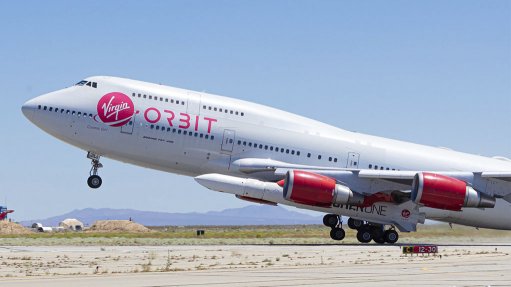
Virgin Orbit’s modified Boeing 747 Cosmic Girl takes off from Mojave with a LauncherOne rocket under its wing
Photo by: Virgin Orbit
US space company Virgin Orbit, part of the UK-based Virgin group (and a sister company to space tourism enterprise Virgin Galactic) successfully launched ten nanosatellites into orbit on Sunday. This was the company’s first successful space launch, achieved on its second launch demonstration mission. (Its first launch demonstration had been a failure.)
Based in California, Virgin Orbit operates from the Mojave Air and Space Port in that State. The ten nanosatellites, also popularly called CubeSats, were carried and successfully deployed on behalf of the US National Aeronautics and Space Administration’s Launch Services Programme.
Virgin Orbit employs the air launch technique. That is, the space rocket (more formally, the satellite launch vehicle) not launched from the ground but carried into the sky by a launch aircraft. The rocket is then released at altitude – 10 000 m or more – thereby reducing the amount of fuel needed to place a payload into low Earth orbit.
The technique is not new: Orbital Sciences, later taken over by Northrop Grumman, was the first to implement it, starting in 1990, with its highly-successful Pegasus rocket. But Pegasus is a solid-fuelled rocket while Virgin Orbit’s rocket, LauncherOne, is liquid-fuelled, giving it greater power. In fact, Sunday’s mission marked the first time that a liquid-fuelled air launched rocket had successfully reached orbit.
Virgin Orbit manufactures the LauncherOne rockets itself, at a facility in Long Beach, also in California. The rockets are carried aloft by a specially-modified Boeing 747-400, named Cosmic Girl. The air launch technique allows small satellites to be put into orbit from many locations around the world, and at short notice. Thus, the company has already entered into a partnership with the County of Cornwall in England to develop an air launch spaceport at the town of Newquay.
“A new gateway to space has just sprung open!” enthused Virgin Orbit CEO Dan Hart. “That LauncherOne was able to successfully reach orbit [Sunday] is a testament to this team’s talent, precision, drive and ingenuity. Even in the face of a global pandemic, we’ve maintained a laser focus on fully-demonstrating every element of this revolutionary launch system. That effort paid off [Sunday] with a beautifully executed mission, and we couldn’t be happier.”
“Virgin Orbit has achieved something many thought impossible,” highlighted Virgin group founder Sir Richard Branson. “It was so inspiring to see our specially adapted Virgin Atlantic 747, Cosmic Girl, send the LauncherOne rocket soaring into orbit. This magnificent flight is the culmination of many years of hard work and will also set a whole new generation of innovators on the path to orbit. I can’t wait to see the incredible missions Dan and the team will launch to change the world for good.”
Virgin Orbit’s next mission will be its first commercial operation. The company already has launches booked by a wide range of customers, both private- and public-sector, civil and defence. These include Italy’s largest private-sector space company, Sitael, Danish nanosatellite manufacturer GomSpace and US Internet of Things communication low Earth orbit satellite constellation enterprise Swarm Technologies, as well as the US Space Force and the UK Royal Air Force.